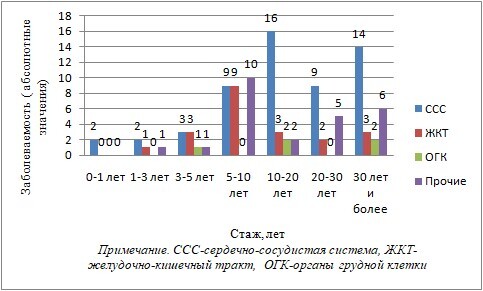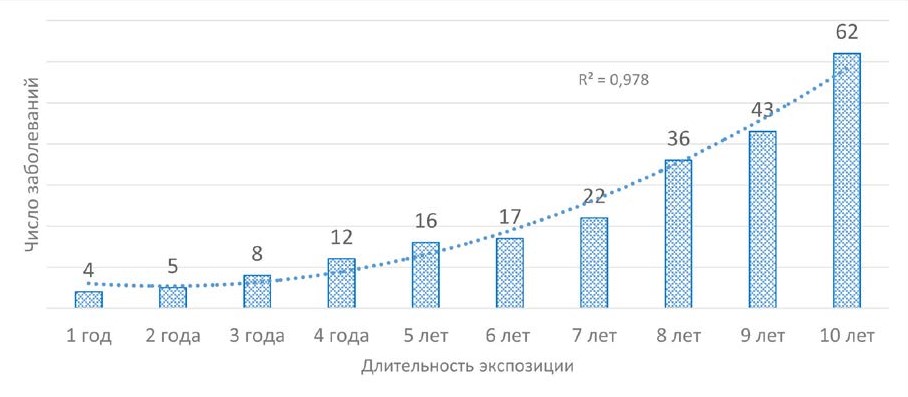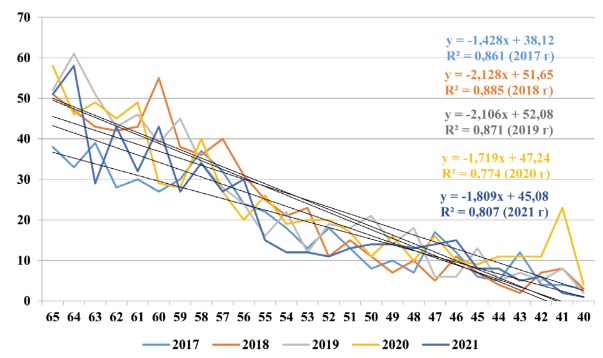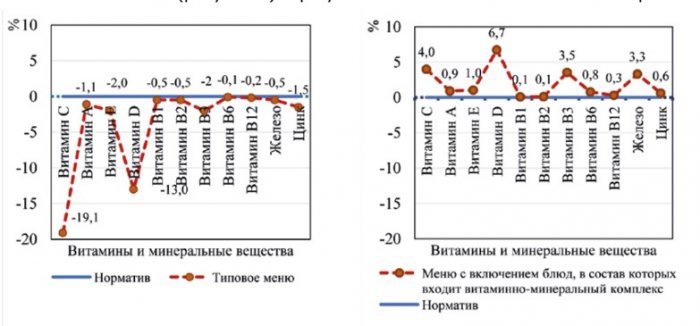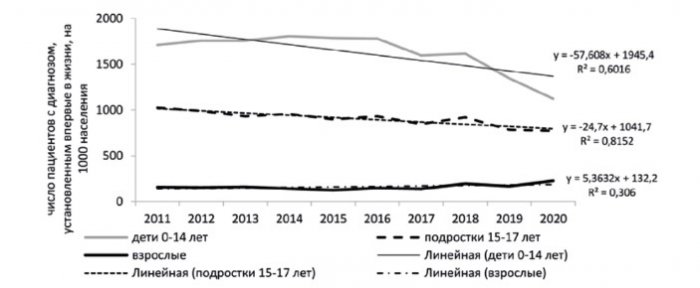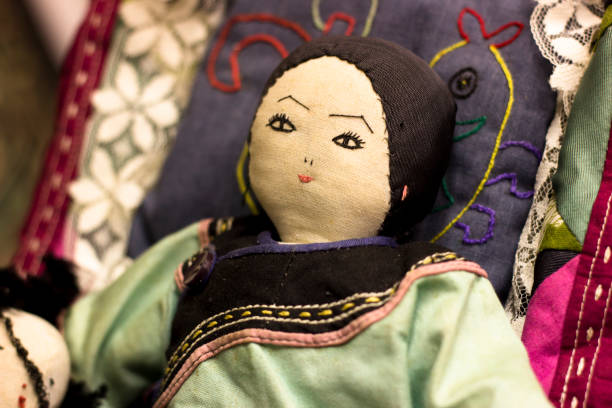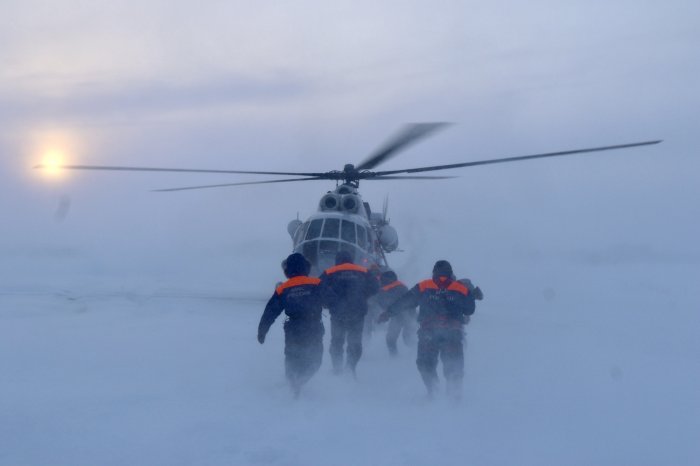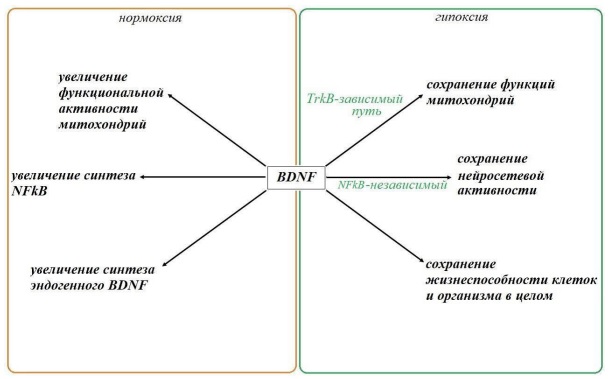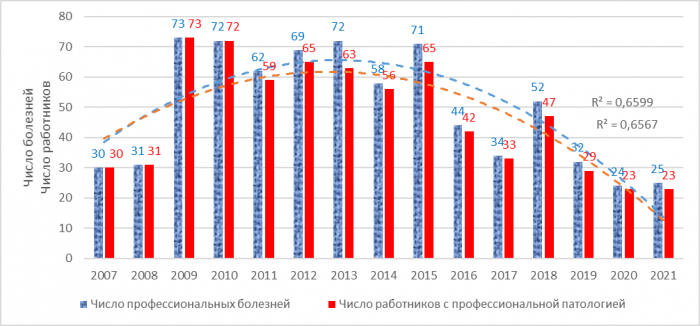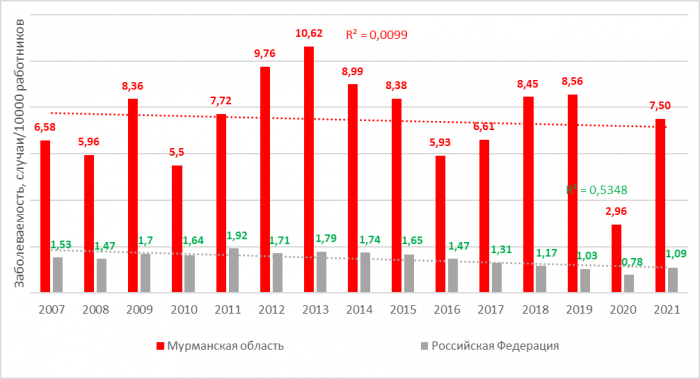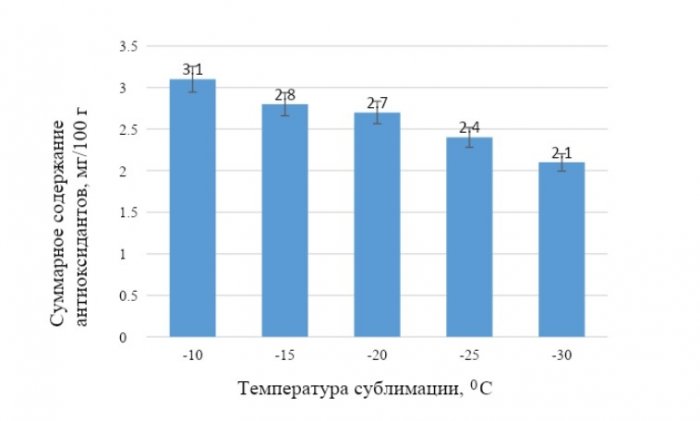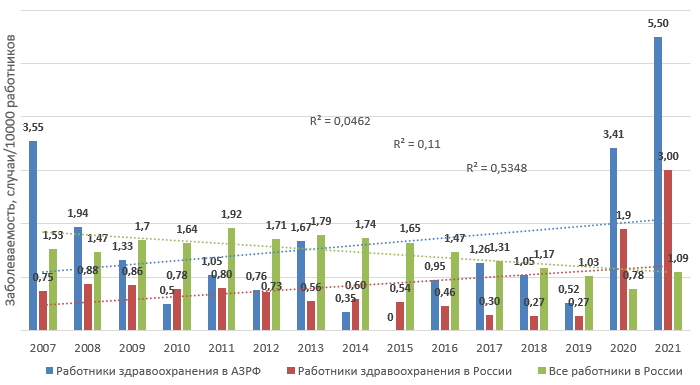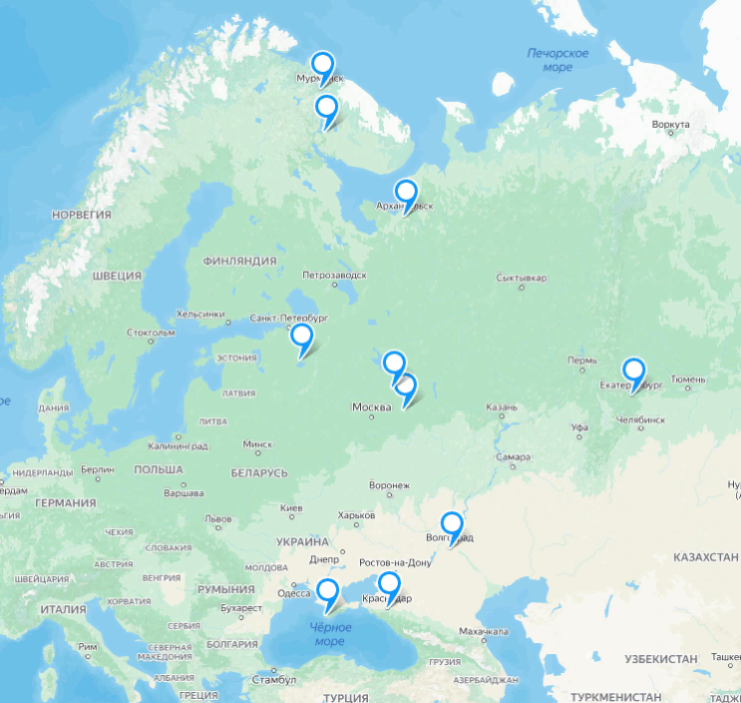Introduction. Combination of the harsh Arctic climate and harmful working conditions has a negative impact on many occupational diseases. The aim of the study was to assess the working conditions and occupational pathology of workers who are involved in oil, gas and coal production in the Arctic. Materials and methods. The data of social and hygienic monitoring “Working conditions and occupational morbidity” of the population of the Arctic zone of Russia in 2007-2017 were studied. Results. It has been established that there are no workplaces in coal mining with satisfactory working conditions, and more than 90% of miners have extremely unsatisfactory workplaces. In contrast, 51.8% of oil and gas workers have satisfactory working conditions and less than 4% work in extremely unsatisfactory conditions. The most common occupational diseases among miners were radiculopathy (32.1%), chronic bronchitis (27.7%) and mono-polineuropathy (15.4%). Within the structure of the occupational diseases of oil and gas industry workers, sensorineural hearing loss (48.8%), radiculopathy (20.9%) and vibration disease (18.6%) prevailed. In 2017, the level of occupational diseases among miners in the Arctic was 2.82 times higher than the national figure, while in oil and gas production it was 1.75 times lower than the national figure. The risk of occupational diseases in coal mining was significantly higher than that of oil and gas production workers (RR=331.1; CI 242.2-452.5). Conclusion. In view of the above, comprehensive measures to protect the health of coal miners in the Arctic are a priority area of work for occupational safety and medicine professionals.
Key words: coal mining, oil and gas industry, working conditions, occupational pathology, Arctic.Introduction Huge mineral resources of the Arctic zone of Russia have led to creation of the largest manufacturing facilities in the country in this area with extreme natural and climatic conditions. These include enterprises engaged in extraction of fuel and energy minerals. The largest oil and gas production enterprises are located in the Yamal-Nenets and Nenets Autonomous Okrugs. Oil and gas are produced to a lesser extent in the Taymyrsky Dolgano-Nenetsky District of Krasnoyarsk Krai and the Chukotka Autonomous Okrug. Coal is mainly mined in Vorkuta and in lesser amounts in the Chukotka Autonomous Okrug and the Taymyrsky Dolgano-Nenetsky District [1, 2, 3, 4].
It is known that the combination of severe natural and climatic conditions of the Arctic regions with harmful working conditions accelerate formation and aggravate progression of many occupational diseases (PD) [5, 6, 7]. Fibrogenic aerosols [8, 9, 10, 11] are considered to be a specific harmful production factor in coal mining, and sulphur-containing compounds (hydrogen sulphide, mercaptans, carbon disulphide, sulphur anhydrite, sulphuric acid anhydride, sulfuric dust), which belong to the substances of the 2nd - 4rth hazard classes [12, 13, 14, 15], are considered to be specific harmful production factors in coal mining. Diseases arising as a result of extraction of minerals, primarily musculoskeletal and nervous systems, respiratory organs, sensorineural hearing loss (noise effects of the inner ear) are the main reason for premature occupational capacity decrement or loss [16, 17, 18, 19].
At the same time, the highest level of occupational morbidity in Russia is observed in coal mining, which in 2017 amounted to 103.11 cases per 10,000 workers [20]. Under conditions of limited human resources, premature termination of employment by qualified specialists is a serious obstacle to the social and economic development of the Arctic region [21].
The “Fundamentals of the state policy of the Russian Federation in the Arctic for the period up to 2020 and long term” [22] has set the task to achieve reliable operation of life support systems and production activities in this important region. Part of this task is to develop a set of measures aimed at preservation of the health and work capacity of the Arctic population.
The purpose of the study was to compare the working conditions and occupational pathology of workers involved in oil, gas and coal production in the Arctic zone of Russia.
Materials and methods. The data of social and hygienic monitoring “Working conditions and occupational morbidity” of the population of the Arctic zone of Russia in 2007-2017 were studied. Information has been delivered by the Federal Hygiene and Epidemiology Centre of the the Federal Service for Supervision of Consumer Rights Protection and Human Well-Being, Moscow. They included data on the annual number of initially diagnosed patients with occupational diseases and their nosological form, the number of persons in contact with the harmful production factors and their nature, the types of economic activities of the diseased, and the type of economic facilities controlled by Rospotrebnadzor.
The research results were processed using Microsoft Excel2010 software and Epi Info, v. 6.04d. The Student's t-test for independent samples, approval criterion, relative risk (RR) and 95% confidence interval (CI) were determined. Numerical data are presented in the form of arithmetic mean and standard error (M±m). Differences in indicators were considered significant at p<0.05.
Results of the study. The data of 1,891 employees, who during the period of 2007-2017 were diagnosed with 2339 occupational diseases for the first time, were studied. Among them, 1,851 persons were employed in coal mining, including 1,777 in Vorkuta, 73 in the Chukotka Autonomous Okrug and 1 in the Taymyrsky Dolgano-Nenetsky District of the Krasnoyarsk Krai. There were 40 people employed in the oil and gas industry, including 34 in the Yamal-Nenets Autonomous Okrug, 4 in the Nenets Autonomous Okrug and 2 in the Taimyr Dolgano-Nenets district. The average age and length of service of the coal mining industry workers were less than that of the oil and gas industry workers, amounting to 50.9±0.1 and 54.2±0.8 years (p<0.001) and 24.5±0.1 and 26.9±1.2 years (p<0.05), respectively. Among the coal miners there were 56 (3.0%) women, while all the employees of oil and gas enterprises were men.
Working conditions in the mining industry were compared based on the average annual number of jobs at the facilities of various supervision groups of sanitary and epidemiological welfare in 2007-2017. It has been established that in coal mining there are no facilities of the first supervision group of sanitary and epidemiological welfare (jobs with satisfactory working conditions), and more than 90% of miners are employed in the facilities of the third supervision group (with extremely unfavourable working conditions). In contrast to miners, more than half of the oil and gas workers were employed in the facilities of first supervision group with satisfactory working conditions, and only 4% of them were employed at the enterprises of the third group of sanitary and epidemiological welfare with extremely unfavourable working conditions. For the number of workers present in each of the three supervised groups, the differences between coal miners and persons employed in the oil and gas companies were statistically significant. In general, there were almost 9 times as many oil and gas workers in the Arctic zone of Russia as there were miners of coal mining companies (Table 1).
Table 1. Average annual number of employees (absolute, %) at the facilities of supervision groups engaged in coal, gas and oil production in the Arctic in 2007-2017
|
Group of the supervised facilities |
Extracted raw materials |
р |
|
|
Coal |
Gas and oil |
||
|
1st |
- |
41873 (51.8) |
<0.001 |
|
2nd |
909 (9.8) |
35782 (44.3) |
<0.001 |
|
3rd |
8331 (90.2) |
3182 (3.9) |
<0.001 |
|
Totally |
9240 |
80837 |
|
When mining coal, miners are more likely to be exposed to strongly fibrogenic aerosols, have a worse illumination, and are effected by a combination of several harmful factors.
Chemical and biological factors, severity of work, noise, infrasound, non-ionizing electromagnetic fields and radiation, ionizing radiation have a greater proportion in the structure of harmful production factors of oil and gas production enterprises workers (tab. 2).
Table 2. Average annual number of employees (absolute, %) exposed to harmful production factors during coal, oil and gas production in the Arctic in 2007-2017
|
Harmful production factor |
Extracted raw materials |
р |
|
|
Coal |
Gas and oil |
||
|
Strongly fibrogenic aerosols |
3509 (21.3) |
707 (1.4) |
<0.001 |
|
Chemical factors |
60 (0.4) |
2372 (4.8) |
<0.001 |
|
Severity of work |
171 (1.0) |
2717 (5.5) |
<0.001 |
|
Intensity of work |
210 (1.3) |
626 (1.3) |
- |
|
Noise |
688 (4.2) |
16844(33.8) |
<0.001 |
|
Infrasound |
83 (0.5) |
298 (0.6) |
>0.1 |
|
General vibration |
488 (3.0) |
2214 (4.4) |
<0.001 |
|
Local vibration |
148 (0.9) |
292 (0.6) |
|
|
Nonionizing electromagnetic fields and radiation |
304 (1.8) |
3638 (7.3) |
<0.001 |
|
Ionizing radiation |
11 (0.1) |
464 (0.9) |
<0.001 |
|
Illumination |
2705 (16.4) |
476 (0.9) |
<0.001 |
|
Microclimate |
332 (2.0) |
4779 (9.6) |
<0.001 |
|
Biological factors |
- |
379 (0.8) |
<0.001 |
|
Joint action |
7762 (47.1) |
14022(28.1) |
<0.001 |
Coal miners are more likely to have occupational diseases under working conditions of hazard classes 3.3 and 3.4. Harmful production factors determining development of occupational diseases are mainly severity of work, strongly fibrogenic aerosols and local vibration. All other factors account for only 13.4% of occupational diseases. In the vast majority of cases (92.6%), the reasons for harmful production factors are structural defects of machines, mechanisms and other equipment, as well as imperfection of workplaces.
Oil and gas industry employees are more likely to be diagnosed with occupational diseases when working under hazard class 3.1 conditions. In comparison with miners, occupational pathology is mainly developed because of exposure to noise and general vibration. A common risk factor for occupational diseases in both groups of workers is severity of work. In the oil and gas industry, 80.6% of cases of exposure to harmful production factors is related to imperfection of technological processes and workplaces (tab. 3).
Table 3. The number of occupational diseases arising from various working conditions in coal, oil and gas production in the Arctic in 2007-2017 (absolute, %).
|
Indicator |
Extracted raw materials |
р |
|
|
Coal |
Gas and oil |
||
|
Class of working conditions: |
|
|
|
|
class 2 |
7 (0.3) |
1 (2.3) |
>0.2 |
|
class 3.1 |
273 (11.4) |
18 (41.9) |
<0.001 |
|
class 3.2 |
838 (36.4) |
18 (41.9) |
>0.2 |
|
class 3.3 |
625 (27.5) |
6 (14.0) |
<0.02 |
|
class 3.4 |
502 (22.0) |
- |
<0.001 |
|
class 4 |
51 (2.3) |
- |
>0.2 |
|
Factors causing development of occupational diseases: |
|
|
|
|
Severity of work (class 3.1 and more) |
948 (42.7) |
10 (23.3) |
<0.001 |
|
Fibrogenic aerosols |
581 (24.4) |
1 (2.3) |
<0.001 |
|
Local vibration |
444 (19.5) |
2 (4.7) |
<0.01 |
|
Noise |
199 (8.0) |
21 (48.8) |
<0.001 |
|
Substances of I-IV hazard classes |
90 (4.1) |
1 (2.3) |
>0.5 |
|
General vibration |
25 (1.0) |
7 (16.3) |
<0.01 |
|
Microclimate (cooling) |
7 (0.2) |
- |
>0.5 |
|
Intensity of work |
2 (0.1) |
1 (2.3) |
>0.5 |
|
Circumstances determining the development of occupational diseases: |
|
|
|
|
design defects of machinery, mechanisms, equipment, devices and tools |
1620 (73.1) |
52 (12.1) |
<0.001 |
|
imperfection of workplaces |
428 (19.5) |
117 (27.1) |
>0.1 |
|
technological process imperfection |
214 (6.6) |
255 (59.2) |
<0.001 |
|
malfunctioning of machines and mechanisms |
32 (0.8) |
- |
>0.5 |
|
derogation from the process regulation |
- |
5 (1.2) |
>0.5 |
|
imperfection of technical medical equipment |
2 (0.1) |
2 (0.5) |
>0.5 |
|
violation of safety regulations |
- |
2 (0.5) |
>0.5 |
The number of occupational diseases per miner was higher than an oil and gas worker had: 1.24±0.01 and 1.08±0.04 cases respectively (p<0.001). The nature of health disorders in the two groups of employees compared had significant differences (Table 4). Thus, within the structure of occupational pathology of miners, disorders of musculoskeletal system, respiratory organs and nervous system had a more significant proportion, and within the structure of pathology of workers of oil and gas enterprises, the most common were diseases of the ear and mastoid process, as well as injuries, intoxication and some other consequences of external causes. Miners had radiculopathy, chronic bronchitis and mono-polineuropathy among the three most common nosological units of occupational diseases. Sensorineural hearing loss (inner ear noise effects), radiculopathy and vibration disease were the most common diagnoses of those engaged in gas and oil extraction.
Mineworkers were more likely to be diagnosed with occupational pathologies through periodic medical examinations (56.7%), while oil and gas production personnel were more likely to be diagnosed through self-administration due to health problems (62.8%).
Table 4. Nosological structure of occupational pathology of employees in coal, oil and gas production in the Arctic in 2007-2017 (abs., %).
|
Indicator |
Extracted raw materials |
р |
|
|
Coal |
Gas and oil |
||
|
Occupational disease classes |
|
|
|
|
musculoskeletal disorders |
831 (36.2) |
9 (20.9) |
<0.02 |
|
respiratory disease |
664 (28.9) |
1 (2.3) |
<0.001 |
|
nervous disorders |
516 (22.5) |
3 (7.0) |
<0.001 |
|
diseases of the ear and mastoid process |
199 (8.7) |
21 (48.8) |
<0.001 |
|
injuries, intoxication and some other consequences of external causes |
77 (3.4) |
8 (18.6) |
<0.02 |
|
neoplasms |
6 (0.3) |
- |
>0.5 |
|
circulatory diseases |
3 (0.1) |
- |
>0.5 |
|
diseases of the skin and subcutaneous tissue |
- |
1 (2.3) |
>0.5 |
|
The most common diseases: |
|
|
|
|
radiculopathy |
737 (32.1) |
9 (20.9) |
>0.05 |
|
chronic bronchitis |
637 (27.7) |
- |
<0.001 |
|
mono-polyneuropathy |
354 (15.4) |
3 (7.0) |
<0.05 |
|
sensorineural hearing loss |
199 (8.0) |
21 (48.8) |
<0.001 |
|
vegetative-sensory polyneuropathy |
162 (7.1) |
- |
|
|
vibration disease |
75 (3.3) |
8 (18.6) |
<0.02 |
|
myofibrosis |
52 (2.3) |
- |
>0.5 |
|
osteoarthritis deformans |
32 (1.4) |
- |
>0.5 |
In the Arctic zone of Russia, the annual number of coal miners who had their first occupational diseases, ranged from 108 (2007) to 223 (2013). The level of occupational diseases over the course of eleven years had a significant tendency to increase. All the years it was significantly higher than in oil and gas production in the Arctic zone of Russia, as well as in all types of economic activities in the Arctic zone of Russia and in Russia as a whole (Fig.). In 2017, the level of occupational diseases in coal mining in the Arctic was 2.82 times higher than the same national indicator (103.11 per 10,000 employees). The risk of occupational diseases in coal mining in Vorkuta and the Chukotka Autonomous Okrug did not differ significantly (RR=1.12; CI 0.90-1.40; χ2=1.11; p=0.2919).
The annual number of oil and gas production workers who first were diagnosed with occupational diseases varied from 0 to 7 people. The level of occupational morbidity in oil and gas production during the whole period of observation was lower than in coal production, as well as in all types of economic activities in the Arctic zone of Russia and nationwide. In 2017, these differences were 240.1 times, 9.28 times and 1.08 times, respectively (Fig.). In 2017, the level of occupational diseases in oil and gas production in the Arctic was 1.75 times lower than the same national indicator (2.12 per 10,000 employees). Employees of the main oil and gas producing regions - the Yamal-Nenets Autonomous Okrug and the Nenets Autonomous Okrug - did not have any significant differences in their health risks: RR=2.50; CI 0.89-7.05; χ2=3.23; =0.0724.
Comparison of probability of occupational pathology in the process of extraction of various fuel and energy minerals has shown that it is higher than that of oil and gas in the process of extraction of coal (RR=331.1; CI 242.2-452.5; χ2=1637.8; p<0.001), all economic activities in the Arctic (RR=15.1; CI 15.0-16.5; χ2=20009.5; p<0.001) and nationwide (OP=224.6; CI 195.8-257.5; χ2=44275.4; p<0.001). In oil and gas production, the risk of occupational diseases development was lower than in all economic activities in the Arctic (RR=0.05; CI 0.03-0.06; χ2=767.0; p<0.001) and was close to the nationwide level of occupational diseases (RR=1.08; CI 0.52-2.27; χ2=0.04; p=0.8334).
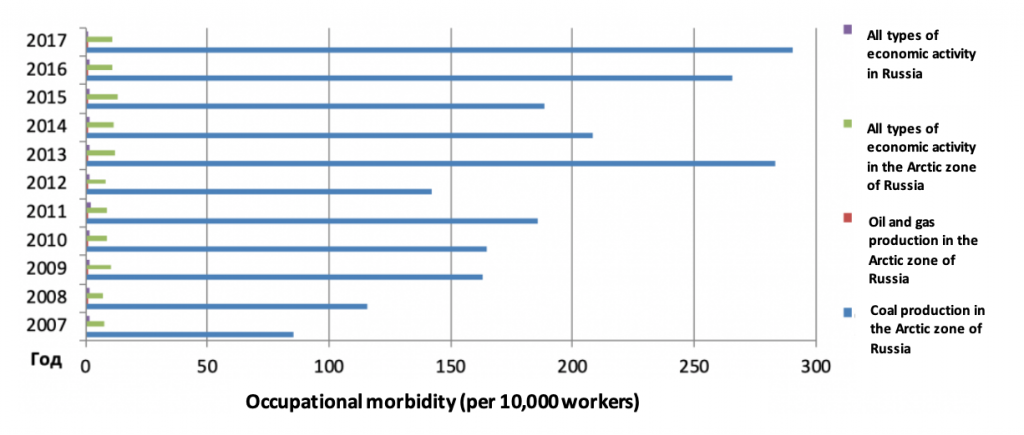
Figure 1. Annual occupational diseases in coal, oil and gas production in the Arctic, all economic activities in the Arctic and in Russia (per 10,000 workers).
The fact that at the time of detection of an occupational disease, the age and length of service of employees of oil and gas enterprises were higher than that of miners, indicates an increase in the period of working capacity under more favourable working conditions.
Two groups of employees, in addition to the different intensity of exposure to harmful production factors, have significant differences in their structure, which probably determines the specifics of emerging health problems. At the same time, it should be noted that the proportion of harmful factors in their overall structure often does not correspond to the etiological significance of the factor in development of occupational pathology. Thus, if within the overall structure of harmful factors which influence coal miners, proportion of increased severity of work and local vibration is 1% and 0.9%, respectively, then within the impacts related to development of occupational diseases it is 42.7% and 19.5%, respectively. A similar situation is observed among the employees of oil and gas production enterprises. 23.3% and 16.3% of occupational diseases were caused by the severity of work and general vibration which made up 5.5% and 4.4% respectively within the total structure of
Since the study was conducted in the Arctic zone of the country, special attention was paid to the frequency of detection of the cooling microclimate of workplaces. It is well known that chronic cold stress contributes to reduction of physical performance and mental capacity, chronic pain syndrome, respiratory diseases, increased risk of industrial injuries [23, 24, 25]. Within the structure of harmful factors at the oil and gas industry enterprises, the cooling microclimate was one of the most widespread (9.6%). However, in none of the cases it was recognized as an etiological factor in development of occupational diseases. A similar situation was observed among coal miners. Within the structure of harmful factors, the proportion of cooling microclimate was 2.0%, and it was considered the reason for development of occupational diseases in 0.2% of the cases. The obtained data allow us to assume that in the course of expert assessment of occupational diseases, significance of some harmful production factors unreasonably increases (e.g., the severity of work), and significance of others is underestimated (e.g., the cooling microclimate).
The obtained data on relatively favourable working conditions and low level of occupational pathology defy stereotypes about the extreme nature of the work of oil and gas production workers in the Arctic [26].
Of course, factors that distort the true state of affairs may be unqualified special assessment of working conditions and periodic medical examinations of workers [27, 28]. It cannot be excluded that the low level of occupational morbidity of oil and gas industry workers can be related to some extent to the widespread work on a rotational basis, which makes it difficult to register all diseases [29, 30]. It may also be important that some workers hide their true health condition to maintain a highly paid job in the gas industry [31].
Conclusion: In 2007-2017, there was no significant improvement in working conditions at coal mining enterprises in the Arctic zone of Russia. The level of occupational morbidity of Arctic miners is 2.82 times higher than the national figures for coal mining and has no tendency to decrease. Compared to miners, oil and gas workers have significantly less harmful working conditions and a low level of occupational diseases. In view of the above, comprehensive measures to protect the health of coal miners in the Arctic are a priority area of work for occupational safety and medicine professionals.
References:
2. Chukotka Autonomous District. Passport. (in Russian). Available at: minpromtorg.gov.ru/common/upload/files/ docs/pasregions/ (accessed 13 Jan., 2019).
4. Kontorovich A.E. Neft' i gaz rossijskoj Arktiki: istoriya osvoeniya v XX veke, resursy, strategiya na XXI vek [Oil and gas of the Russian Arctic: development history in the twentieth century, resources, strategy for the XXI century]. Nauka iz pervykh ruk [First-hand science]. 2015. Vol. 1. № 61. (in Russian). Available at: http://nsu.ru:8080/6d3c28a920ac8 94f92c00d76835d4bc0.
5. Izmerov N.F. Problemy mediciny truda na Krajnem Severe [Problems of occupational medicine in the Far North]. Medicina Truda i Promyshlennaya Ekologiya [Russian Journal of Occupational Health and Industrial Ecology]. 1996. № 5. Р. 1-4. (in Russian).
6. Profilaktika professional'nyh zabolevaniy, vyzvannyh sochetannym vozdeystviem vibracii, shuma i ohlazhdayushhego mikroklimata na predpriyatiyah gornodobyvayushhey promyshlennosti: metodicheskie rekomendacii [Prevention of occupational diseases caused Russian Arctic 6/2019 49 by the combined effects of vibration, noise and cooling climate in the mining industry: guidelines]. Moscow, 1991. (in Russian).
7. Myshinskaya J.M. Vliyanie klimaticheskih i ekologicheskih faktorov na zdorov'e cheloveka v usloviyah Krajnego Severa [The influence of climatic and environmental factors on human health in the Far North]. Yamalskiy Vestnik [Yamal Bulletin]. 2016. Vol. 2. № 7. Р. 79-80. (in Russian).
8. Laney A.S.,Weissman D.N. Respiratory Diseases Caused by Coal Mine Dust. Journal of Occupational and Environmental Medicine. 2014. Vol. 56. № 010. Р. 18–22. doi: [10.1097/ JOM.0000000000000260]. Available at: https: //www.ncbi. nlm.nih.gov/pmc/articles/PMC4556416/. (accessed 13 Jan., 2019).
9. Timofeeva S.S., Murzin M.A. Pylevaya nagruzka pri dobyche uglya i professional'nye riski [Dust load in coal mining and occupational hazards]. Vestnik IrGTU [Bulletin of IrTU]. 2015. Vol. 5. № 100. Р. 68-71. (in Russian).
10. Blackley D.J, Halldin C.N., Laney A. S. Continued Increase in Prevalence of Coal Workers’ Pneumoconiosis in the United States, 1970–2017. American Journal of Public Health. 2018. Vol. 108. № 9. Р. 1220–1222. doi: 10.2105/AJPH.2018.304517. (accessed 13 Jan., 2019).
11. Beer C., Kolstad H. A., Søndergaard K., Bendstrup E., Heederik D., Olsen K. E. et al. A systematic review of occupational exposure to coal dust and the risk of interstitial lung diseases. European Clinical Respiratory Journal, 2017. Vol. 4. 1264711, doi: 10.1080/20018525.2017.1264711. Available at: https://doi.org/10.1080/20018525.2017.1264711. (accessed 13 Jan., 2019).
12. Esswein E.J., Alexander-Scott M., Snawder J., Breitenstein M. Measurement of area and personal breathing zone concentrations of diesel particulate matter during oil and gas extraction operations, including hydraulic fracturing // Journal of Occupational and Environmental Hygiene. 2018. Vol. 15. № 1. Р. 63-70. doi: 10.1080/15459624.2017.1388512. Available at: ttps:// www.ncbi.nlm.nih.gov/pubmed/ 29053946 (accessed 19 Jan., 2019).
13. Witter R.Z., Tenney L., Clark S., Newman L.S. Occupational exposures in the oil and gas extraction industry: State of the science and research recommendations. //American Journal of Industrial Medicine. 2014. Vol. 57. № 7. Р. 847–856. doi: 10.1002/ajim.22316. Available at: https://www.hcn.org/ articles/cdc-reports-suspected-oil-and-gas-inhalationfatalities (accessed 19 Jan., 2019).
14. Kireev I.R., Murzabaeva E.I., Saidova A.K. Ohrana zdorov'ya personala v neftyanoj promyshlennosti [Protecting the health of personnel in the oil industry] //Vestnik molodogo uchenogo UGNTU [Bulletin of the Young Scientist of USTU]. 2016. Vol. 8. № 4. Р. 127–32. (in Russian).
15. DotsenkoYu.I., Boyko V.I., Gudinskaya N.I., Mukhamedzyanova R.I. Nekotorye aspekty gigieny truda v neftegazovoj promyshlennosti [Some aspects of occupational hygiene in the oil and gas industry] //Sovremennye Problemy Nauki i Obrazovaniya [Modern Problems of Science and Education]. 2017. № 5. Available at: http://www.science-education.ru/ru/ article/view?id=26774 (accessed 19 Jan., 2019). (in Russian).
16. Solonin Yu., Pancheva G., Boiko E. Work environment and workers´ health risks in the coal industry of the Komi Republic (Russian Federation). Barents Newsletters on Occupational Health and Safety. 2009. Vol. 12. № 1. Р. 5-6.
17. Gudimov D.V., Chemezov E.N. Professional'nye zabolevaniya v ugol'noj promyshlennosti Respubliki Saha (Yakutiya) [Occupational diseases in the coal industry of the Republic of Sakha (Yakutia)]. Gornyy informacionno-analiticheskiy byulleten' (nauchno-tekhnicheskiy zhurnal) [Mining Information and Analytical Bulletin (scientific and technical magazine)]. 2014. № 9. Р. 348–351 (in Russian).
18. Ikonnikova N.V. Morbidity of gas-transport company workers, and measures to reduce it [Zabolevaemost' rabotnikov gazotransportnogo predpriyatiya i meropriyatiya po ee snizheniyu] // Meditsina Truda i Promyshlennaya Ecologiya [Russian Journal of Occupational Health and Industrial Ecology]. 2017. № 9. Р. 83-4. (in Russian)
19. Manoj Kumar R.M, Karthick R.B, Bhuvaneswari V., Nandhini N. Study on Occupational Health and Diseases in Oil Industry. International Research Journal of Engineering and Technology. 2017. Vol. 4. № 12. Р. 954-958. Available at: https://www.irjet.net/archives/V4/i12/IRJET-V4I12180.
20. O sostoyanii sanitarno-epidemiologicheskogo blagopoluchiya naseleniya v Rossijskoj Federacii v 2017 godu: Gosudarstvennyj doklad. Federal'naya sluzhba po nadzoru v sfere zashchity prav potrebitelej i blagopoluchiya cheloveka [On the state of sanitary and epidemiological welfare of the population in the Russian Federation in 2017: State report]. Moscow. 2018. (in Russian).
21. Krasulina O. Y. Arkticheskaya zona Rossijskoj Federacii: osobennosti prirodno-ekonomicheskih i demograficheskih resursov [Arctic zone of the Russian Federation: features of natural, economic and demographic resources]. Regional'naja ekonomika i upravlenie [Regional Economics and Management]. Available at: https://eee-region.ru/ article/4805/ (accessed 19 Jan., 2019). (in Russian).
22. Ob osnovakh gosudarstvennoy politiki RF v Arktike na period do 2020 goda I dal'neyshuyu perspektivu [On the fundamentals of the state policy of the Russian Federation in the Arctic for the period up to 2020 and beyond] Rossiyskaya gazeta [Russian newspaper]. № 4877. 18.09.2008 (in Russian).
23. Anttonen H., Pekkarinen A., Niskanen J. Safety at work in cold environments and prevention of cold stress //Industrial Health. 2009. Vol. 47. № 3. Р. 254–261.
24. Hassi J., Rytkönen M., Kotaniemi J., Rintamäki H. Impacts of cold climate on human heat balance, performance and health in circumpolar areas //International Journal of Circumpolar Health. 2005. Vol. 64. № 5. Р. 459–467.
25. Kue T., Mäkinen T. The health of Arctic populations: Does cold matter? // American Journal of Human Biology. 2010. № 22. Р. 129–133.
26. Syurin S.A., Gorbanev S.A. Professional'naya patologiya na predpriyatiyah Neneckogo avtonomnogo okruga: faktory riska, struktura, rasprostranennost' [Occupational pathology at the enterprises of the Nenets Autonomous District: risk factors, structure, prevalence] // Gigiena i sanitariya [Hygiene and Sanitation]. DOI: http://dx.doi.org/10.18821/0016-9900- 2019-98-6-652-656 (in Russian).
27. Khoruzhaya O.G., Gorblyansky Yu.Yu., Piktushanskaya T.E. Kriterii ocenki kachestva medicinskih osmotrov rabotnikov [Criteria for assessing the quality of medical examinations of workers]. Meditsina Truda i Promyshlennaya Ekologiya, [Russian Journal of Occupational Health and Industrial Ecology]. 2015. № 2. Р. 21-26. (in Russian)
28. Syurin S.A., Gorbanev S.A. Профессиональная патология: как сохранить здоровье работающего человека [Occupational pathology: how to maintain health of a working person]. Bezopastnost´ i OkhranaTruda [Occupational Safety]. 2018. № 3. Р. 48-50 (in Russian)
29. Alekseenko V.D., N.N. Simonova N.N., Zueva T.N. Vliyanie proizvodstvennyh faktorov na sostoyanie zdorov'ya rabotnikov neftedobychi pri vahtovoj organizacii truda v Zapolyar'e [The impact of production factors on the health status of oil production workers in rotational labor organization in the Arctic]. Ekologiya Cheloveka [Human Ecology]. 2009. № 5. Р. 47-50. (in Russian).
30. Korneeva Ya.A., Dubinina N.I., Simonova N.N., Degteva G.N., Fedotov D.M. Riski v professional'noj deyatel'nosti vahtovyh rabotnikov v usloviyah Krajnego Severa [Risks in the professional activities of rotational workers in the Far North]. Byulleten' VSNTs SO RAMN [Bulletin of WSSC of SB of RAMS]. 2013. Vol. 91. № 3. Р. 83–88. (in Russian).
31. Dubinina N.I., Degteva G.N., Korneeva Ya.A. Osobennosti provedeniya predvaritel'nyh i periodicheskih medicinskih osmotrov personala v usloviyah raboty vahtovym metodom na Arkticheskom shel'fe [Features of the preliminary and periodic medical examinations of staff in working conditions on a rotational basis on the Arctic shelf]. Byulleten' VSNTS SO RAMN [Bulletin of WSSC of SB of RAMS]. 2012. Vol. 87. № 5. Р. 127–30. (in Russian.).

